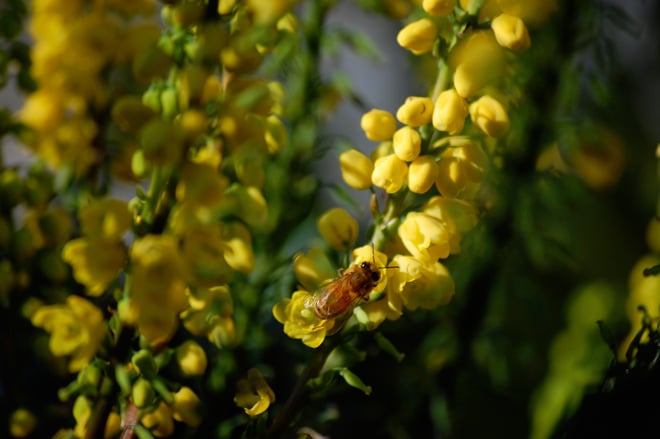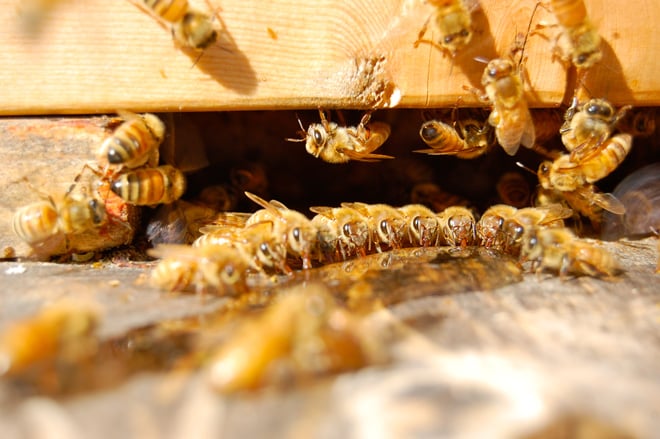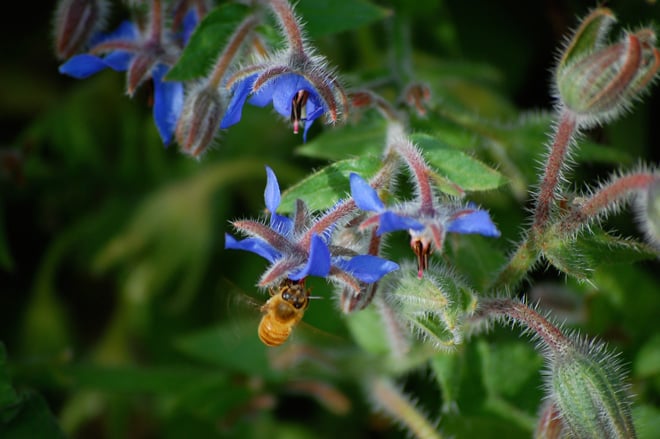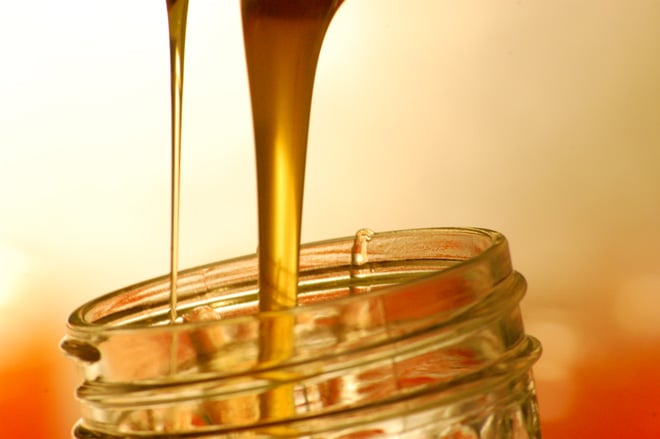
Gardening with Backyard Bees

Contributor
Decked out in fresh white bee suits, we look like clumsy cosmonauts as we shake the three-pound box of honeybees into the new hive. About 10,000 Apis mellifera dart around in circles, a buzzing vortex of stinging insects. We are nervous. Why won’t they go into the hive? Nerves become panic. What did we do wrong?
Later, consulting our resources, we read that newly introduced honeybees fly in a figure-eight pattern to orient themselves to the position of the sun, horizon, and other important navigational reference points in their new location. There seemed to be no end to the fascinating mysteries we encountered as we embarked on our backyard beekeeping adventure.
Before literally pouring those bees into the hive, we lodged the captive queen deep in the hive, safe in her pill bottle-sized house. Most of these bees were thrown together at the apiary: they’ve just met and need to be bewitched by the queen’s royal pheromones to become one with the hive mind. Until this happens, she is seen as an invader to be destroyed. But once the worker bees catch her pheromone drift (we’re told it smells like lemongrass) they become desperate and gnaw away at the strategically placed marshmallow stopper to get to her and begin attending to her royal needs.
The queen is an egg-laying machine, a full-time job, so her attendees must feed, groom, and do everything else for her. Over the season, she will lay around 2000 eggs a day—likely over a million in her lifetime.
But we aren’t thinking about any of that right now as thousands of bees swarm our backyard, orienting to their new home. Sweat trickles down our faces. The bee suits are hot. More than a few bees threateningly bounce off of our veils with an angry high-pitched buzz. It’s tough to resist the urge to swat. We ask ourselves, “Why we are doing this?”

In the beginning, we had romantic notions about becoming bee whisperers. We saw the YouTube videos: suitless, gloveless beekeepers effortlessly communing with their hives. And who can forget that image “Man with a beard of bees.” We are completely over that now.
For us, it’s about the garden, the 75-year-old Gravenstein that shades us in the summer, covered with fruit, not to mention the plum, persimmon, and Asian pear trees, as well as blueberries, raspberries, strawberries, and all the other plants in our little urban food garden that require sweet honeybee love to set fruit.
And it’s more. We’re concerned about colony collapse disorder, the frightfully real prospect of losing honeybees for good. Scientists believe a number of environmental factors from pesticide residue to urbanization work together to weaken their resistance to disease.
Plus, it turns out that mono-cropping beehives, like all monoculture, greatly contributes to the spread of those diseases. Quoting a 2009 documentary film, Vanishing of the Bees, “What is going to save honeybees is changing from one guy with 6000 hives to 6000 backyard beekeepers with one hive.” The idea that we could make a difference helped us to override our fears and take the plunge.

That was three years ago now. Our romantic notions have been dispelled and we’ve confronted the realities of beekeeping. It’s expensive. You buy the hive, the frames, the smoker, the suits, and then you need space to store everything. Also, it hurts when they sting you—and they will sting you!
Another reality is bees get diseases and parasites, which you must learn about, monitor for, and treat to help your hive surmount the odds. And even if you do everything right you might lose them anyway. Crushed that first year when we lost our hive over the winter, we subsequently learned that even experienced beekeepers suffered losses, which they attributed to the unusually wet winter. There are no guarantees with beekeeping.
We learned we couldn’t expect to finance our expensive hobby with honey sales. Because of the low price of honey, beekeeping is not particularly lucrative unless you are doing it at scale. We harvested 20 pounds of honey from our one hive this fall, just enough for us to enjoy and share with friends.
For these two veteran gardeners, the steep learning curve has been humbling. There’s much that can’t be learned from books, and we found we needed coaching from experienced beekeepers. Local beekeeping societies have long been hip to this, and will set you up with a mentor if you show up at their meetings. But regardless of the challenging realities we are enraptured by our new hobby and fascinated by how it has changed how we garden.

Once our hive was up and running, we were drawn into close observation of the bee world. Transported to a micro-cosmos, we closely watched the interplay between bees and flowers. Plant sex was a whole new experience and every bloom became an opportunity to watch bees—our bees?—caressing anther and stamen. Once we began looking we also noticed a whole world of native pollinating insects, every flavor of bumble, fly-like mason bees, and an iridescent green bee we have no name for. There were so many different pollinators, each with unique flower preferences. We noticed our honeybees seem to prefer blue and gold blooms. We learned from observation. Who knew that honeybees don’t like tomato blossoms but bumblebees do? They also ignored the marigolds we placed around the vegetable garden and shunned our rhododendrons. On warm summer evenings as worker bees are returning to the hive, we often pull up lawn chairs and watch what we affectionately term “Bee TV.”
Sometimes called bee bread, pollen is an important food source for bees that is high in protein. Honeybees have little sacs on their hind legs that they stuff with pollen as they forage. Pollen comes in different colors, visible in these pollen baskets as the bees enter the hive. Observing pollen paniers of yellow, pink, orange, red, grey, lavender, and even blue, sent us off to research which color pollen was from what plant.
The native bigleaf maple (Acer macrophyllum) has light yellow pollen and is an important early food source for honeybees in the Pacific Northwest. When we noticed brown pollen packs coming into the hive, we traced it to the red maple (Acer rubrum) street trees on the next block. Blossoms from the plum tree, borage, and blackberries in the alley all have pollen in shades of grey, and blueberry pollen is surprisingly orange.
We began to think of plants in our garden as food sources to support the bees. We’ve learned to see the beauty in a plant’s entire life cycle instead of just its productivity for our use. Now we let some vegetables such as broccoli, parsley, cilantro, mustard, and onion, bloom and reseed.

During the second spring of our backyard bee experiment, we began to actively seek out honeybee plants, and our garden palette tilted heavily toward the flower colors our bees prefer. We planted masses of goldenrod (Solidago) and giant hyssop (Agastache ‘Blue Fortune’), thinned the free-wheeling borage, and seeded our whole parking strip with Phacelia tanacetifolia, otherwise known as bee plant. Where we used to enjoy browsing nurseries for plants with unique ornamental qualities, now we scan for flowers the honeybees will visit. Ornamental grasses and daylilies in our borders have lost a bit of their luster since the bees couldn’t care less for them. But the clover in our lawn stays and has never looked better. Our eye for beauty has changed.
Thinking so much about available forage for our bees has effectively extended the boundaries of our garden into surrounding plant communities. We think of their entire flying range as our garden. Our bees depend on the lavender hedge on the corner, the row of hawthorn trees on a nearby side street, and a prodigious stand of sunflowers at the local community garden.
Master beekeepers have an encyclopedic knowledge of phenology and know exactly what bee plant is blooming at what time. The real art is adjusting this calendar to local weather conditions and knowing to supplement the hive’s diet when there are gaps in the food supply. Honeybees can fly an average of two miles from the hive as they collect pollen and plant nectar. Flights of three to five miles are not unusual. In our neighborhood, we’ve battled large swaths of Himalayan blackberry and knotweed for years. Now, with both chagrin and delight, we acknowledge them as the very plants that sustain our hive; blackberries bloom from late June through August, and knotweed extends the nectar season into October. A bountiful crop of dandelions in a vacant lot are not merely tolerated but are accepted as an audacious form of food security for the hive.
Not only do we feel connected with flora and fauna but also with our neighbors. Our hive creates a community of sorts, as our neighbor across the alley chides us to “get your bees back in your own yard” and the people next door snap pictures of us in our bee suits to post on Facebook. It is easier to have those over-the-fence conversations about pesticide use since, now, “it’s about the bees.” People get that.

Last fall, as we finished harvesting and putting up the 20 pounds of honey, being sure to leave plenty for the hive to overwinter, we truly grasped how amazing honey really is. It’s estimated that to make one pound of honey the bees need to visit at least 1 million flowers and fly an estimated 50,000 miles. This nectar from countless flowers is then evaporated by the wings of the some 50,000 to 70,000 worker bees that make up a hive in the peak of the season. When the honey is ready, only 18 percent of the original water remains; any more and the honey would ferment. Instead, it’s sweet magic.
Our backyard beekeeping experiment has been an enlivening challenge and we are still learning. Even if we stop keeping bees at some point, we are forever changed because the hive has connected us more fully with the fragile web of life and helped us create an even more healthy and vibrant ecosystem on our 1000 square feet of earth.
Here is a list of plants loved by our bees (by no means complete)
Annuals
Broccoli, kale or any other flowering cruciferous vegetable
Rocket, Arugula Eruca sativa
Onion Allium
Spider flower Cleome hassleriana
Bee plant Phacelia tanacetifolia
Parsley Petroselinum crispum
Cilantro Coriandrum sativum
Borage Borago officinalis
Sunflower Helianthus
Evening primrose Oenothera biennis
Breadseed poppy Papaver somniferum
Perennials
Sea Kale Crambe cordifolia and C. maritima
Lavender Lavandula
Mint Mentha spp.
Oregano Origanum vulgare and O. laevigatum ‘Hopley’s Purple’)
Bee Balm Monarda didyma
Giant Hyssop Agastache ‘Blue Fortune’
Goldenrod Solidago
Coneflower Echinacea purpurea
Catmint Nepeta spp.
Sage Salvia officinalis
Shrubs
Hebe Hebe spp.
Mexican orange Choisya ternata
Japanese holly Ilex crenata
Oregon Grape Mahonia aquifolium and M. bealei
Snowberry Symphoricarpos albus
Blueberry Vaccinium myrtillus
Heavenly bamboo Nandina domestica
Privet Ligustrum japonica
Common laurel Prunus laurocerasus
Manzanita Arctostaphylos
Raspberries Rubus spp.
Strawberries Fragaria spp.
Trees
Fruit trees Apple, pear, cherry etc.
Persimmon Diospyros kaki
Hawthorne Crataegus
Crabapple Malus
Maple Acer
Share:
Social Media
Garden Futurist Podcast
Most Popular
Videos
Topics
Related Posts

Low Maintenance Gardens – Better for Pollinators and People
Autumn 2022 “I come out every day. It’s therapy, my meditation.” Janet’s young garden transformed from overgrown, invasive plants to mostly natives. The dailiness of

Calochortophilia: A Californian’s Love Affair with a Genus
Summer 2022 I can chart the progression of my life by Calochortus. For the last two decades, at least. As a teenage girl growing up

Pacific Plant People: Carol Bornstein
Spring 2022 Public gardens play a key role in demonstrating naturalistic planting design, selecting native and adapted plants for habitat, and testing techniques for reducing

Add Year-Round Interest and Winter Blooms for Pollinators
Spring 2022 This article was created from an Interview by Merrill Jensen with Neil Bell in the Summer of 2021 for our Pacific Plant People











Responses